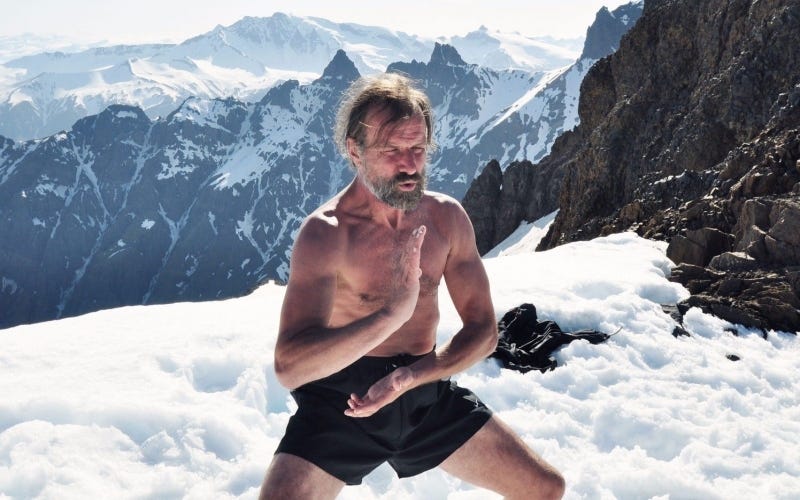Is Wim Hof Full of Shit?
On gurus, self-help, and the power of breathing
It’s been an exhausting year. With the US presidential election almost behind us, we all need a break from the news cycle and associated doom scrolling. Several months ago, I fell down a self-help rabbit hole, which I’m surprised to say changed my life. The transition is surprising because I’ve long held a dim view and deep skepticism of the self-help industry.
This view has become especially acute since I moved to Cape Town. In one of the world’s most unequal cities, the self-help industry is big business for the privileged. There are more yoga studios here than I can count. Just about everyone with the means is involved in some type of endurance sport, has a special diet, and practices some form of self-help.
The obsession with these activities is a form of narcism that can only flourish in an unequal space like South Africa. The privileged have the luxury of time to explore themselves while the masses toil with little food and the brutality of unfettered capitalism. I’m fully aware that I’m throwing stones in a glass house here. I’m one of the privileged few who has the time to train to run 90-km races, surf when the waves are good, and swim in the cold Atlantic.
It was the swimming that brought me to Wim Hof and my self-help rabbit hole. Now that I’m spending more time in the water, I decided to research the benefits of cold water exposure for mental health. This led me to the gangly Dutch guru Wim Hof. For the better part of the last decade, Hof has used his breathwork techniques and cold water immersion to pull off some truly insane stunts like climbing nearly to the top of Everest in little more than swimming shorts.
After watching a compelling mini-documentary about his pursuits, I decided to give his breathing method a try. Since I was already immersing in cold water regularly through my swim training, I thought his breathing techniques may improve my ability to deal with the cold. I had no idea it would profoundly alter my mood and unlock unconscious memories from my childhood.
Laying in bed one night, I started the breathing method by following the embedded YouTube video from Hof’s page below. After the first session, which took 10 minutes, I felt like my body was newly energized. The exercise is straightforward. You take 30-40 intense breaths. After the final breath, you exhale entirely and then hold your breath. The magic happens during the breath retentions.
Since you’ve pushed so much oxygen into your body during the first part, you can hold your breath for an unusually long time. You begin to feel tingly and almost light. You can feel your heartbeat and blood moving around your body. When you need air, you take a deep breath in and hold for 10 seconds. That’s one round. I started with three rounds in one session; now I do about 10. The more rounds I do, the longer and more profound my breath holds are.
To go deeper and hold my breath longer, I needed to learn how to quieten my mind. Since the brain uses about 15-20 percent of the body’s oxygen, any technique that focuses the mind will dramatically improve the length of time you can hold your breath. Eventually, I landed on a simple but proven method of being fully in the present. When I close my eyes, I simply focus on the blackness. Is it close or far away? What colors and shapes can I see? By focusing on these questions, I forced myself to be present with a calm mind.
One day, I was working on this trick when all of a sudden I had a vision of my elementary school playground. It was as if I was looking down from a drone. I could move around and enter my old school. More than three minutes passed as I occupied that space with no air in my lungs. During the next breath hold, I went back to my school. Since that session, I have had more visions from my childhood. Each one is different and equally profound. The visions are like vignettes from a dream but I’m able to access them in a fully conscious state.
Last week, Hof published a new book. He describes how visions like the one I described above are common in his breathwork. Your breath is a door, he notes, it leads to corridors that take us deep within ourselves. Ordinarily, I would dismiss this rhetoric as new-age hot air but having experienced the power of breathwork, I’m forced to reassess my position.
Is Wim Hof full of shit? Probably a little bit. His breathing techniques are borrowed from eastern traditions. But that doesn’t matter. The more accurate question is whether we are full of shit. When you let your guard down, the breath can expand as big as the ocean, and you can swim in the depths of your subconscious. If you have 10 minutes, try it out for yourself and see.
Some things I read recently
The court battle over a single baboon and his rights in Cape Town
Why tunnels in the US cost much more than anywhere else in the world
From Palestine to the world, the militant film of the PLO
Fraudulent indigenous art is flooding museums
A final thought
There are approximately 62,000 miles of veins, arteries, and capillaries in each and every one of us.



Wim Hof changed my life!
Like it.